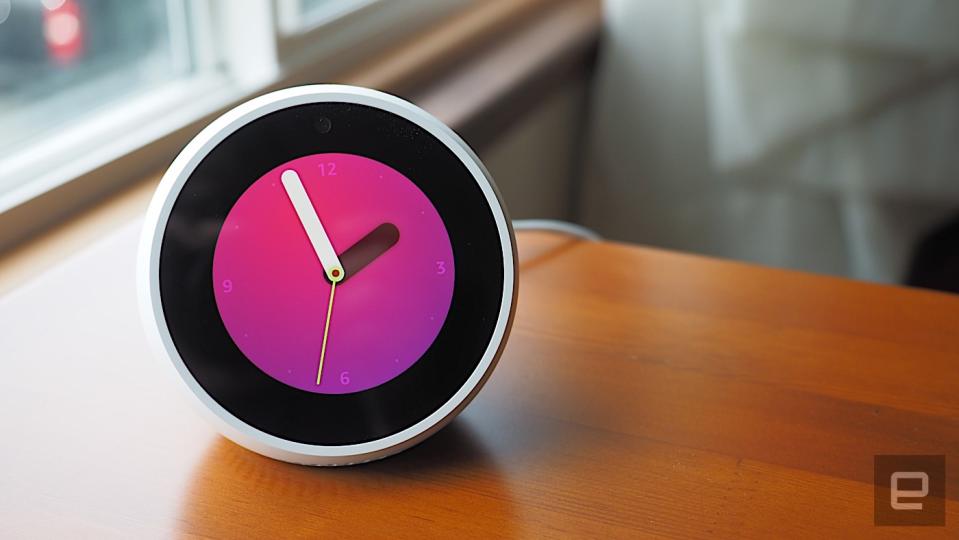Amazon Echo Spot review: As smart as it is cute
This alarm clock's tiny screen belies a big feature set.
When Amazon unveiled the Echo Show earlier this year, we questioned if we really needed an Echo with a touchscreen. Surprisingly, the display turned out to be quite useful -- it was good for video, making calls or just displaying bite-sized information. But its peculiar mall-kiosk design left a lot to be desired, especially for people thinking of putting it in a central location in their home.
A few months later, however, Amazon unveiled the Echo Show's smaller, more adorable sibling: the Echo Spot. It has all the same functionality as the Show, except it's wrapped in a much cuter package. Yet, its small size is also something of a downside, as it's not ideal for watching video. That makes its $130 asking price a little harder to swallow.
Hardware
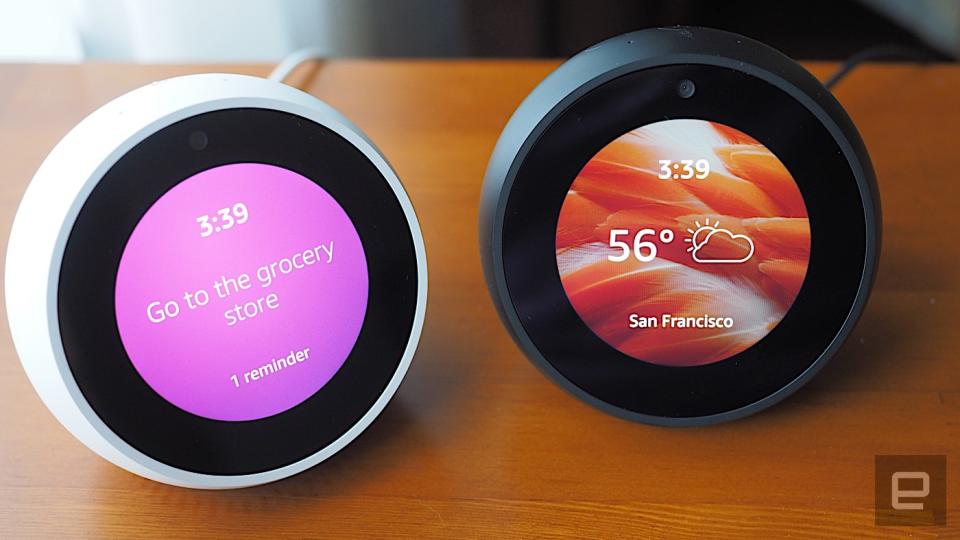
The Echo Spot is quite possibly the cutest product Amazon has ever made. Its circular display and spherical body lend it the charm of a retro alarm clock. Of course, the Echo Spot can also be used in other rooms in the house -- it's pretty useful in the kitchen too -- but it'll look right at home on your nightstand.
Sticking with the alarm clock theme, the Spot is relatively compact and lightweight. It measures 4.1 x 3.8 x 3.6 inches and weighs 14.8 ounces (0.9 pound), making it easy to move around. The whole thing is fashioned out of a sturdy matte plastic, available in either black or white. I'm a fan of the white model myself -- the contrasting black bezels surrounding the circular display add some visual interest.
That display is indeed a full circle; there's no so-called flat tire at the bottom. It measures 2.5 inches across and has a 480 x 480 resolution. That might sound terrible, but for such a tiny screen, it's more than adequate. Plus, the Spot isn't something you'll be staring at for hours on end, so the low resolution gets a pass.
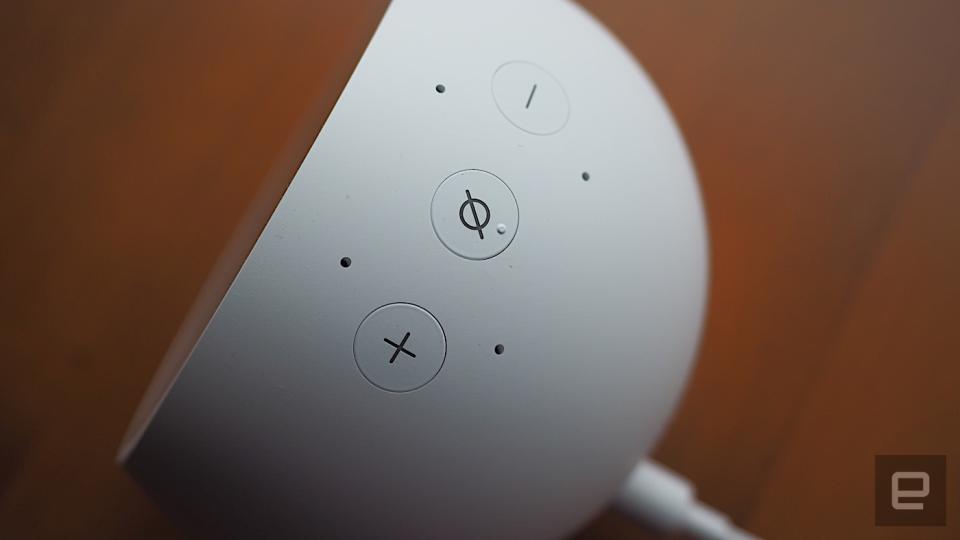
Otherwise, I really like the Spot's screen. It's bright, colorful and the viewing angles are wide. I found that the small display was perfectly functional for showing basic information like the weather, a calendar overview, trending headlines and to-do lists. It also works well for video calling -- there's a VGA camera above the display just for that -- though I wouldn't advise using it for watching longer videos (more on that in a moment).
Swiping down from the top of the display reveals a settings menu, where you can enable Bluetooth, change WiFi settings and disable the camera, among other things. This is also where you adjust the Spot's brightness levels, which is important for dimming the lights when you're sleeping. You can also choose up to 12 different clock faces in both analog and digital designs. If you like, you can use your own personal photos as your clock's wallpaper -- just upload your chosen image using the Alexa app or Prime Photos. Of course, the touchscreen also works for swiping through lists or playing and pausing media. You'll still be using Alexa for the majority of tasks, but the touchscreen adds an extra layer of functionality.
The Spot has three buttons on top: two for the volume and one that disables the microphone and the camera. On the back is a 3.5mm audio jack that acts as a line out for dedicated speakers or headphones. Internally, there's a 2x2 microphone array plus WiFi and Bluetooth radios. When Alexa is listening, a blue circle appears on the display; when the microphone is muted, that circle turns red.
In use
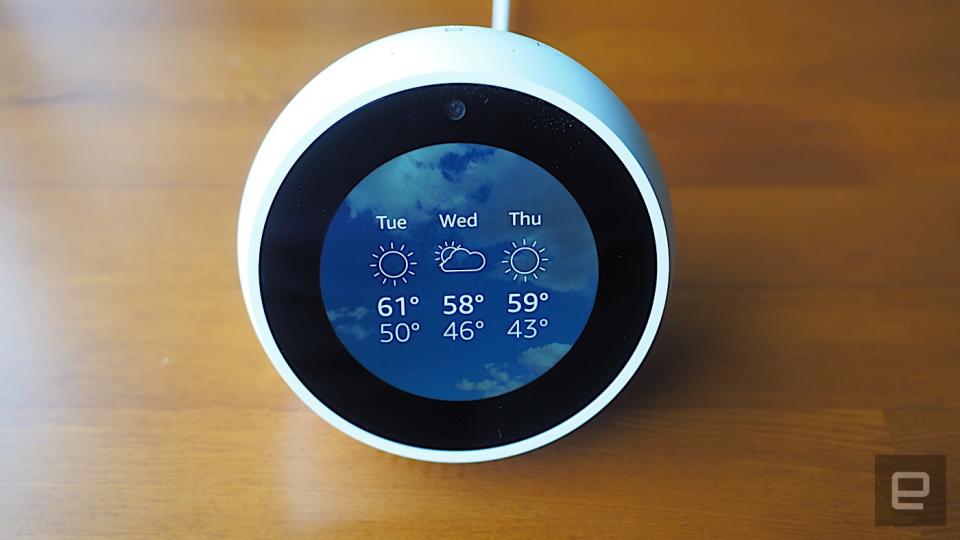
Like other Echo devices, the Spot is easy to set up. The screen makes that process especially easy. Simply plug it in, and on-screen instructions will walk you through. When prompted for a WiFi password and your Amazon login credentials, you can use the Spot's touchscreen keyboard to enter those in. If you like, you can also use the Alexa app (available on iOS and Android) to set up the Spot, but it's not necessary. Once you're done, the device plays a short welcome video.
At this point, it would seem that the Echo Spot functions a lot like a regular Alexa-powered Echo. Using the Alexa app, I connected my Google Calendar for setting up appointments. I also hooked up my Spotify and Amazon Music accounts. You can ask it for the time or the weather, play music or just ask Alexa some basic search queries. The Spot also works with compatible smart home appliances, and supports a wide assortment of so-called skills, like making lists, setting reminders and even playing Jeopardy. But, as with the Show, the benefit of the Spot is that you can also see Alexa's answers on-screen, which is often more helpful than just listening to them.
For example, when you ask Alexa for the weather, the Spot will show you the highs and lows of the day, as well as the weather for the next six days (along with the chances of precipitation). When adding items to your shopping list, the device reveals the other items in your list without you having to ask. If you're setting up a second alarm 30 minutes after your first one (I have multiple wake-up alarms; don't judge me), it'll show you the one you already set. In other words, the Spot's display sometimes expands on what Alexa gives you, with more information than you initially asked for. It's not necessary, but it sure is convenient.
Even when the screen doesn't elaborate on Alexa's answer, being able to look and interact with the display is useful. When you ask for trending topics, for example, the Spot shows you a scrolling list of headlines while reciting the first three. You can then ask Alexa to read any one of them in more depth, or you could just scroll and tap through the list yourself. As I found, reading it on your own is often faster than having Alexa do it for you.
By default, the Echo Spot rotates between the time, weather, upcoming calendar appointments, your to-do list, a selection of trending stories and a list of "Things to try," which amount to suggestions on how to use the device.
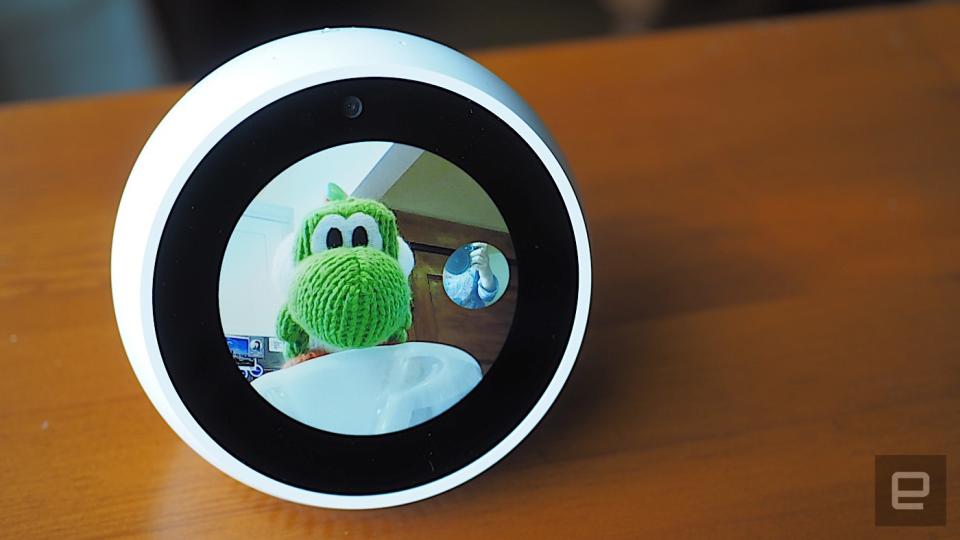
As for voice commands, the Spot had few problems recognizing my voice, even when I was speaking from across the room. However, it did struggle to pick up what I was saying if there was a lot of surrounding noise. When I had the Echo Spot's volume maxed out playing a song, for example, I had to get a few feet closer so that it could hear me.
You can already make voice calls and send messages with the screen-less Echos, but the display and camera on the Spot means video calls are now possible. You can make video calls with anyone with an Echo Spot or Show, as well as anyone with the Alexa app installed on their phone.
I tested this feature by using the Spot to call two of my colleagues, Cherlynn and Nate, who have the Alexa app on their phones. Cherlynn also owns a second-generation Echo. When I tried calling her, her Echo rang, but her phone did not. While I could talk to her, then, we couldn't see each other. She tried switching the call to her phone, but it didn't work. It seems that if you're making a call from an Echo to another person, it prioritizes their Echo over the phone. That makes sense to an extent, but I'd rather be able to choose how I answer the call.
When I tried calling Nate, however, his phone rang. He answered by launching the Alexa app, at which point both cameras immediately kicked in and we could see each other. It worked well -- the video quality was crisp and smooth, partially thanks to the fact that we both had decent WiFi connections. The audio quality was good, too. I can see the Spot being useful for helping families keep in touch, though bear in mind that you'd have to force everyone to download the Alexa app to make it work.
The Echo Spot also doubles as an intercom when paired with other Echos in your house. So, if you're in the bedroom and you have an Echo in the kitchen, you can say "Drop in on the kitchen" and communicate with anyone on the other side. If the other Echo is a Spot or a Show, the cameras will turn on as well. If you'd rather not have the camera on but you still want to chat, you can always hit the camera off button or disable it in settings.
Another handy feature on the Spot (as well as the Show) is the ability to use it as a monitor for a webcam. That includes the Amazon CloudCam of course, but it also works with Nest, Ring and any other camera that has the "Works with Alexa" label. I happen to have a CloudCam already installed, so I could say "Alexa, show me the family room" to get a peek at what my cat was up to when I wasn't around.
Music and media
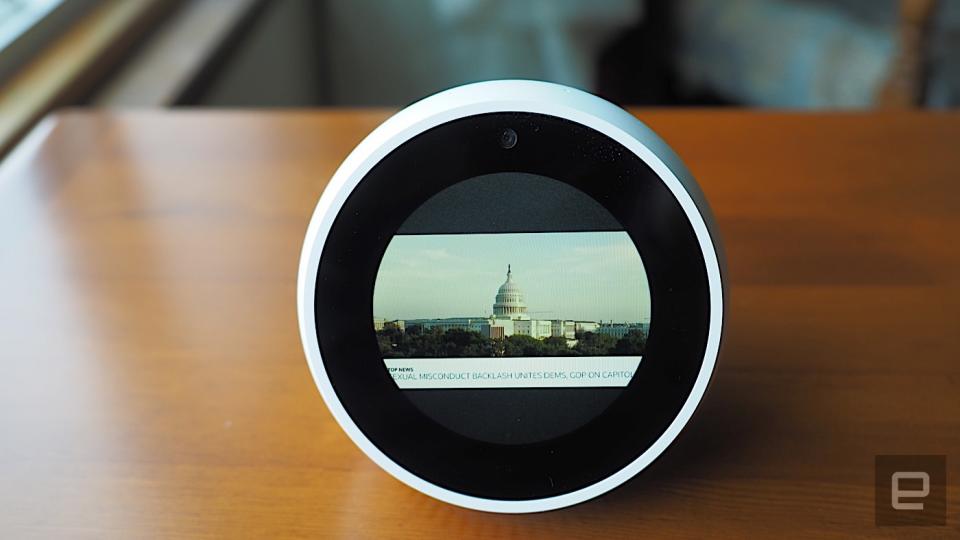
Like other Echo devices, the Spot can be used for music playback. Say "play holiday tunes," for example, and it'll play a pre-curated list of Christmas songs from Amazon Music. Since there's a display, you can also view album art, check out the top playlists on Spotify or tap the screen to play and pause. I especially like that certain songs on Amazon Music will show scrolling lyrics, so you can sing along.
That said, the Spot's 1.5-inch speaker is not for audiophiles. The sound quality is OK, but not great. It's at least better than I expected -- it's crisper and fuller than the Dot, and even bests the speakers on my Macbook Air -- but the bass is middling and none of the instruments really stand out. For casual listening, the Echo Spot is decent, but those who want better sound should connect to external speakers via Bluetooth or the line-out port.
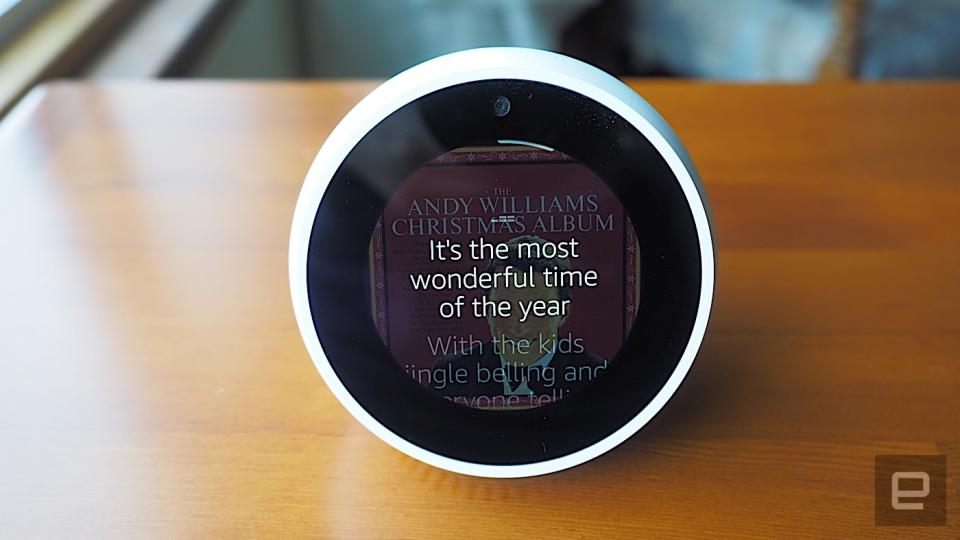
As I mentioned earlier, another thing you can do with the Spot is watch videos. You can watch content from Amazon Prime, movie trailers or short "flash briefing" news videos (from sources like Reuters and Bloomberg TV). As you can imagine, watching anything on a tiny, circular screen isn't going to be a great experience. You can zoom in on the video so it fills the screen or zoom out if you'd like to see more. But no matter what, that circular display will never show you the full view of the video; there will always be parts on the sides that get cut off.
While I could imagine myself watching 30-minute sitcoms on the larger Echo Show, I can't imagine doing that on the Spot. The screen is just too small. But with shorter news snippets or movie trailers, I didn't think the experience was so bad. That's because shorter videos are often intended for conveying information in small bites, which is what the Echo Spot is particularly good at in the first place.
That makes it a shame that YouTube is missing on the Echo Spot. This is not really Amazon's fault per se, as it seems like Google pulled its support, but it's still a downside to keep in mind.
The competition
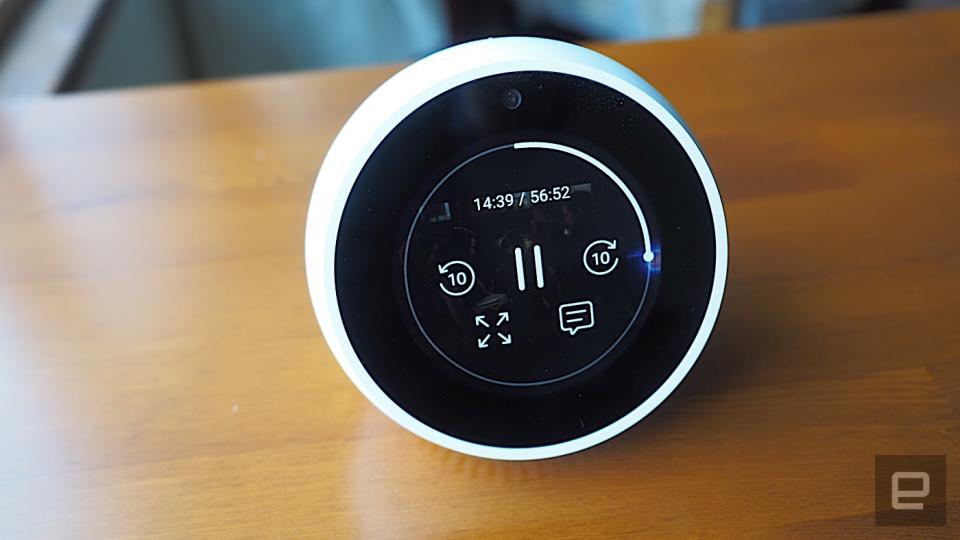
There aren't a lot of devices like the Echo Spot, but perhaps its most direct rival is its bigger stablemate, the Echo Show. The Show only costs $20 more, and for the money you get a larger display that's better suited for watching video. The sound quality is better, too. On the other hand, you could save about $50 by getting the $80 screen-less second-gen Echo or save even more with the $30 Echo Dot, if having a screen isn't important.
And if you're considering screen-less Echos at all, it's worth looking at Google's offerings, too. The Google Home speaker cost $79 while the Home Mini is only $29. Sure, Google Assistant isn't quite as mature a product as Alexa, but Google might be a better choice if you're already entrenched in its ecosystem.
Wrap-up
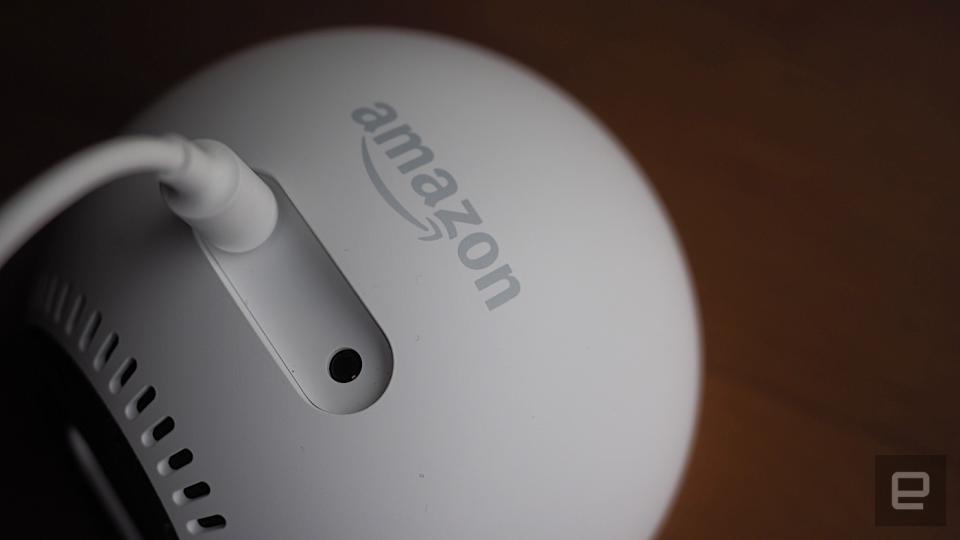
I adore the Echo Spot. It looks great on my nightstand, and I love using it in the kitchen to look up recipes or add to my grocery list. The screen enhances the standard Alexa experience; I love being able to see the information rather than just listen to it. Video-calling is also a bonus. Plus, who knows what other uses Amazon and third-party developers will add to the display over time. For me, it's worth the $50 premium over the screen-less Echos.
Yet, right now, the Spot really is just a smart alarm clock. The tiny display isn't great for much beyond short videos, and even though I find the screen useful, it's not really necessary. Even though it's not Amazon's fault, the lack of YouTube could also be a dealbreaker for some. So, while I really do like the Echo Spot, I'd recommend waiting for its price to drop.

